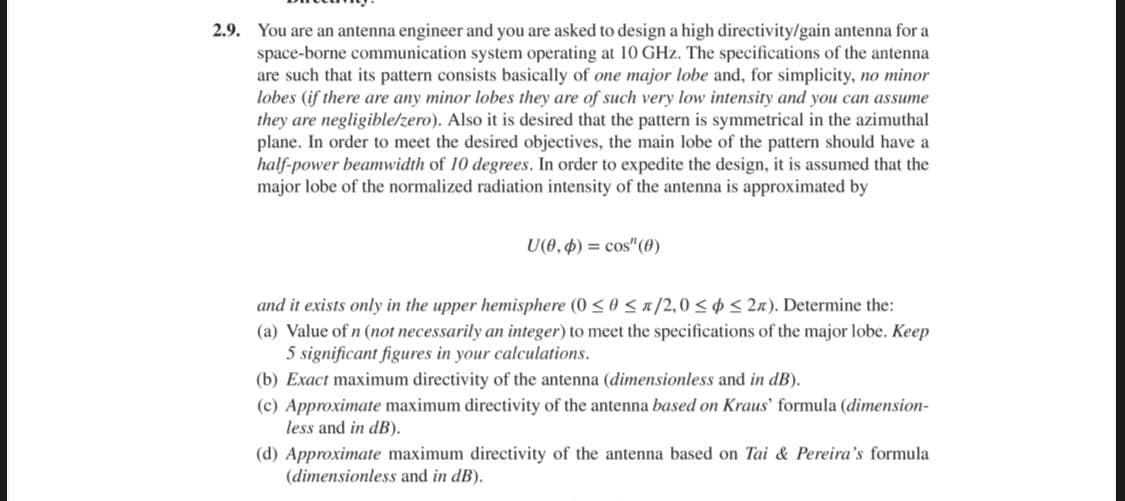You are an antenna engineer and you are asked to design a high directivity/gain antenna for a space-borne communication system operating at 10 GHz. The specifications of the antenna are such that its pattern consists basically of one major lobe and, for simplicity, no minor lobes (if there are any minor lobes they are of such very low intensity and you can assume they are negligible/zero). Also it is desired that the pattern is symmetrical in the azimuthal plane. In order to meet the desired objectives, the main lobe of the pattern should have a half-power beamwidth of 10 degrees. In order to expedite the design, it is assumed that the major lobe of the normalized radiation intensity of the antenna is approximated by U(0,4) = cos"(0) and it exists only in the upper hemisphere (0 <0
You are an antenna engineer and you are asked to design a high directivity/gain antenna for a space-borne communication system operating at 10 GHz. The specifications of the antenna are such that its pattern consists basically of one major lobe and, for simplicity, no minor lobes (if there are any minor lobes they are of such very low intensity and you can assume they are negligible/zero). Also it is desired that the pattern is symmetrical in the azimuthal plane. In order to meet the desired objectives, the main lobe of the pattern should have a half-power beamwidth of 10 degrees. In order to expedite the design, it is assumed that the major lobe of the normalized radiation intensity of the antenna is approximated by U(0,4) = cos"(0) and it exists only in the upper hemisphere (0 <0
Introductory Circuit Analysis (13th Edition)
13th Edition
ISBN:9780133923605
Author:Robert L. Boylestad
Publisher:Robert L. Boylestad
Chapter1: Introduction
Section: Chapter Questions
Problem 1P: Visit your local library (at school or home) and describe the extent to which it provides literature...
Related questions
Question

Transcribed Image Text:2.9. You are an antenna engineer and you are asked to design a high directivity/gain antenna for a
space-borne communication system operating at 10 GHz. The specifications of the antenna
are such that its pattern consists basically of one major lobe and, for simplicity, no minor
lobes (if there are any minor lobes they are of such very low intensity and you can assume
they are negligible/zero). Also it is desired that the pattern is symmetrical in the azimuthal
plane. In order to meet the desired objectives, the main lobe of the pattern should have a
half-power beamwidth of 10 degrees. In order to expedite the design, it is assumed that the
major lobe of the normalized radiation intensity of the antenna is approximated by
U(0, 4) = cos"(0)
and it exists only in the upper hemisphere (0 <0 < x/2,0 <¢ < 2n). Determine the:
(a) Value of n (not necessarily an integer) to meet the specifications of the major lobe. Keep
5 significant figures in your calculations.
(b) Exact maximum directivity of the antenna (dimensionless and in dB).
(c) Approximate maximum directivity of the antenna based on Kraus' formula (dimension-
less and in dB).
(d) Approximate maximum directivity of the antenna based on Tai & Pereira's formula
(dimensionless and in dB).
Expert Solution
This question has been solved!
Explore an expertly crafted, step-by-step solution for a thorough understanding of key concepts.
This is a popular solution!
Trending now
This is a popular solution!
Step by step
Solved in 2 steps with 2 images

Knowledge Booster
Learn more about
Need a deep-dive on the concept behind this application? Look no further. Learn more about this topic, electrical-engineering and related others by exploring similar questions and additional content below.Recommended textbooks for you

Introductory Circuit Analysis (13th Edition)
Electrical Engineering
ISBN:
9780133923605
Author:
Robert L. Boylestad
Publisher:
PEARSON

Delmar's Standard Textbook Of Electricity
Electrical Engineering
ISBN:
9781337900348
Author:
Stephen L. Herman
Publisher:
Cengage Learning

Programmable Logic Controllers
Electrical Engineering
ISBN:
9780073373843
Author:
Frank D. Petruzella
Publisher:
McGraw-Hill Education

Introductory Circuit Analysis (13th Edition)
Electrical Engineering
ISBN:
9780133923605
Author:
Robert L. Boylestad
Publisher:
PEARSON

Delmar's Standard Textbook Of Electricity
Electrical Engineering
ISBN:
9781337900348
Author:
Stephen L. Herman
Publisher:
Cengage Learning

Programmable Logic Controllers
Electrical Engineering
ISBN:
9780073373843
Author:
Frank D. Petruzella
Publisher:
McGraw-Hill Education

Fundamentals of Electric Circuits
Electrical Engineering
ISBN:
9780078028229
Author:
Charles K Alexander, Matthew Sadiku
Publisher:
McGraw-Hill Education

Electric Circuits. (11th Edition)
Electrical Engineering
ISBN:
9780134746968
Author:
James W. Nilsson, Susan Riedel
Publisher:
PEARSON

Engineering Electromagnetics
Electrical Engineering
ISBN:
9780078028151
Author:
Hayt, William H. (william Hart), Jr, BUCK, John A.
Publisher:
Mcgraw-hill Education,